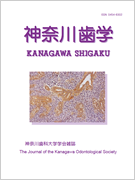- HOME
- > 一般の方
- > バックナンバー:神奈川歯学
- > 35巻2/3号
- > アブストラクト
アブストラクト(35巻2/3号:神奈川歯学)

Japanese
| Title : | 小児歯肉炎の疫学的研究 |
|---|---|
| Subtitle : | ロジスティック回帰分析による罹患程度と環境要因の関連について |
| Authors : | 寺本幸代 |
| Authors(kana) : | てらもとさちよ |
| Organization : | 松本歯科大学小児歯科学講座 |
| Journal : | 神奈川歯学 |
| Volume : | 35 |
| Number : | 2/3 |
| Page : | 82-100 |
| Year/Month : | 2000 / 9 |
| Article : | 原著 |
| Publisher : | 神奈川歯科大学学会 |
| Abstract : | 近年, 小児齲蝕の著しい減少と軽症化の傾向が認められている1~7). このことは, 生活環境の改善を指向した小児保健レベルでの具体的な指導が齲蝕減少といった面から大きな効果をもたらしたと思われる. 一方, 小児の歯周疾患は低年齢化と増加傾向にあり3~8), 6歳で約20%, 12歳で約60%と高い水準の罹患のまま成長・発達期を過ごしている実態が示されている7). 小児の歯周疾患は局所的な原因により惹起される不潔性歯肉炎, あるいは歯の萌出, 交換といった生理的現象に伴ってみられる萌出性歯肉炎が大部分を占め, 高度な骨破壊を伴う例は稀であるとされている9~11). しかしながら, この時期の歯周疾患は多くの要因が相互に, かつ複雑に絡み合いながら発症・進行するとされ, ライフサイクルの中で増齢とともに増加傾向にあることが指摘されている7,12). また, McCall13), Parfitt14)の経年的観察では, 成人にみられる歯周疾患の根源はすでに小児期の慢性辺縁性歯肉炎として発症することを指摘し, 本邦で小児歯肉炎を経年的に追跡した美濃口ら15)は歯肉炎の治癒率は約4%であったのに対し, 歯肉炎が継続しているものが約15%, 歯肉炎から歯周炎に移行したものが約30%であったと報告している. |
| Practice : | 歯科学 |
| Keywords : | ロジスティック回帰, 小児歯肉炎, 環境要因 |
English
| Title : | Epidemiological Study of Pediatric Gingivitis Relationship between Morbidity and Environmental Factors by Logistic Regression Analyses |
|---|---|
| Subtitle : | |
| Authors : | Sachiyo TERAMOTO |
| Authors(kana) : | |
| Organization : | Department of Pediatric Dentistry,Matsumoto Dental University |
| Journal : | Kanagawa Shigaku |
| Volume : | 35 |
| Number : | 2/3 |
| Page : | 82-100 |
| Year/Month : | 2000 / 9 |
| Article : | Original article |
| Publisher : | Kanagawa Odontological Society |
| Abstract : | Recently, pediatric periodontal disease in lower aged and increased number of children has been reported however, because the clinical symptoms are insufficient compared to those in adults, requests for prevention are less than those in other dental diseases such as dental caries. However, it has been reported that the root of periodontal disease in adulthood period was already present in the pediatric period therefore, it is important to obtain appropriate indices for this period to establish preventive measures. The purpose of this study was to clarify the relationships between pediatric gingivitis, whose cause is difficult to understand as a single factor because of the close relationship with daily life, and the oral environment regarding individual habits, behavior, or attitude. We performed our analyses using logistic regression analyses and evaluated the results. 1. From the results of multivariate analyses excluding confounding factors, "gender", "tooth-brushing habits", and "regularity of between meal snacking" were selected as risk factors thatpromote infant gingivitis. 2. Regarding infants, it was suggested that morbidity of gingivitis was more influenced by the addition of "daily intake frequency of meat" as a modification factor, which was a result of univariate analyses, to the risk factors obtained by multivariate analyses. 3. Regarding school children, "PHP score", which indicates dental plaque adhesion, and "frequency of changing toothbrushes" were selected as risk factors that promote gingivitis, from the results of multivariate analyses. 4. It was suggested that morbidity of gingivitis in school children was more influenced by the addition of "gender", which showed a significant difference as a result of univariate analyses, to the risk factors obtained by multivariate analyses. 5. It was suggested that as factors that influence the morbidity of pediatric gingivitis, physiological factors or factors of eating habits were more involved than intraoral factors in infants, and intraoral factors were involved in school children. |
| Practice : | Dentistry |
| Keywords : |
